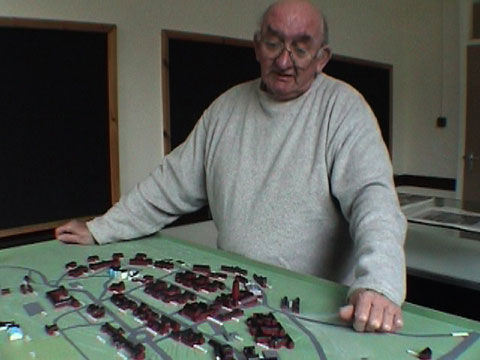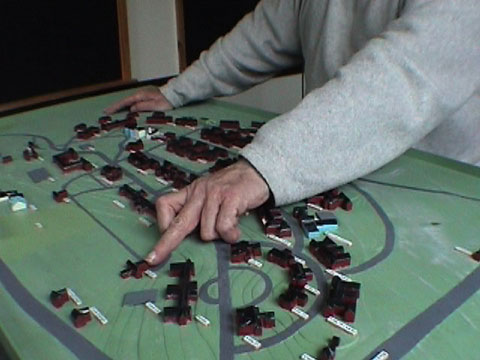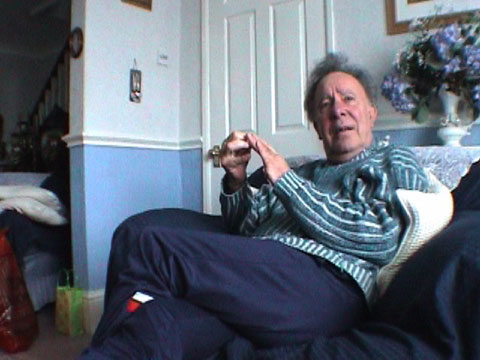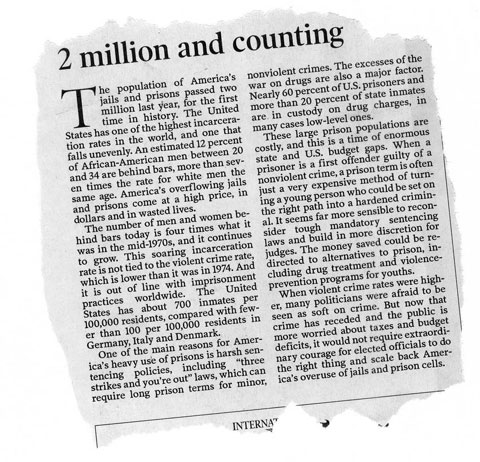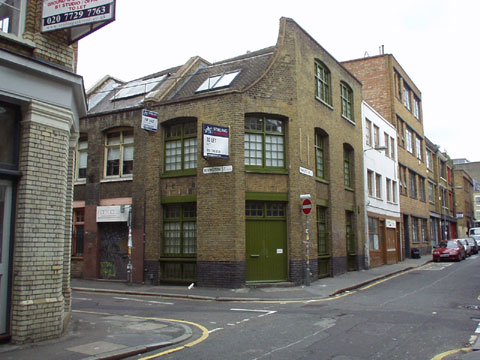Notes on institutions, anti-institutions and self-institutions
Text based on presentation at the Control Seminar, August 16th February 2003
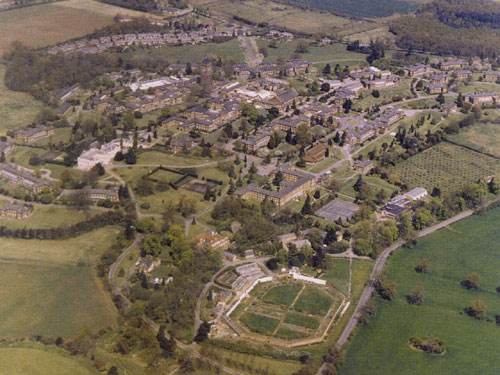
Shenley Mental
Hospital
The meanings of words and concepts develop out of collective material processes. In special situations various individual experiences and social struggles can meet and imbue these concepts with many layers of significance. Such formations of words and concepts can then become part of the elaboration and expansion of the struggles and the interpretation of the experiences that initiated the words and concepts in the first place.
Henriette and I began to use the concept of ‘self-institutionalisation’ in relation to the establishment during 1998 and 1999 of a project space, Info Centre, in East London. For us this was the start of a series of practical experiments with the construction and use of institutions. Info Centre was a combined exhibition space, archive and bookshop. The first ‘info sheet’ of the Info Centre stated: “We are committed to an understanding of art practice that is not exclusively related to the making of art works, but also includes the establishing of institutions for the experience and use of art and generally the making of institutions for human life.”
Behind this point of view was uneasiness with the then pervasive notion of ‘institutional critique’. What had began life in the 1960s as an interesting new practice had, by the late 1990s become ossified into a reflex towards, rather than a passionate refusal of, power. The critique had outlived any critical function and appeared blind to its social, historical and political context. The moments of revolution and renewal you find with early conceptual art and the Situationist International had disappeared. The institutional critique had lost its force as art institutions adapted to these new forms of critique – as capital and its institutions often do. Those practising institutional critique found themselves dependent upon the very historical bourgeois art institutions they were purporting to critique, and that were, anyway, in the latter stages of their disappearance. The critique was irredeemably complicit with art institutions as they turned critique into new forms of spectacle. When we write ‘art institution’ we refer to the social-economical conglomerate of galleries, foundations, museums, institutes, educational facilities, magazines and councils that constitute the basis of the dominating understanding of art in a society. Institutional critique and other anti-institutional practices of the late 1990s did not make these institutions more diverse and rich, but instead ensured the amplification and concentration of power within an ever narrowing system.
This was the background to our decision to construct an institution, when we established Info Centre. We saw this self-institution as a parallel to other institutions in society, particularly art institutions. But inevitably we soon found that our institution made materially more sense to us in our every day life, than most of the other institutions we encountered. We were not interested in being perceived as an anti-institution, because we had no interest in positioning Info Centre in relation to mainstream institutions or the dominate culture, which are usually so closely tied together. And we did not view mainstream institutions or the dominate culture as necessarily being in opposition to us; we simply refused them in their totality. This construction of an institution was not intended to be a critique, but instead a means to take control of both production and distribution. It represented an escape from oppositional institutional critique through the total refusal of the dominate institutions’s monopoly of power. From the beginning Info Centre was intended to be a temporary institution(1) and was terminated in the summer of 1999 after 16 months of activity.
Since Info Centre we have continued to work with the concept of self-institutionalisation through Infopool in London and the Copenhagen Free University. Our understanding of institutions continues to develop especially the nature of their constitution, their practice and their shifting historical role in society, especially within the last 20-30 years. This research has focused on institutional practices in society in general and has focused on art institutions specifically, which are just one category amongst many in modern capitalist societies.
As part of our research we have examined in detail the breakdown of a particular institution, a mental hospital outside London, and how institutional critique and anti-institutional practices assisted in the demise of both this institution and the its own critique and practices. This research looked at institutional forms in relation to the so-called disciplinary society and the slow disintegration of these forms after the Second World War. An omen of this breakdown was the 1960s anti-psychiatric movement led by R.D. Laing and David Cooper in the UK. The anti-psychiatric movement was experimental and based on an existential psychiatry, having its point of departure the experience and reactions to individuals to the normalising pressures of society. Anti-psychiatry was also closely connected to the wider counter-cultural ideas, which, at this time, were particularly pervasive. Emerging from anti-psychiatry came several anti-institutions, including an anti-hospital (Villa 21) and an anti-university (London Anti-University).
Bob Dearden on Shenley Mental Hospital: “I was senior nursing office at Shenley Mental Hospital, which is situated in Shenley near Radlett, probably St. Albans is better known than Radlett and it is in Hertfordshire. Shenley Hospital was built in 1934 by Laing’s. The hospital was the last of the mental hospitals built in this country. It is built on the villa system. If you look at the model you will see that all wards have four outside wards [surely this is walls?] whereas that in the traditional mental hospitals they was usually built around a corridor with wards leading off, so places like Shenley became very expensive to heat and light and maintain as every ward had – as I said – four outside wards [walls]. The hospital itself was built on an axis east to west and on an axis running north to south. The administrative block was the centre of the hospital with all the main services running down the central axis – the engineering workshops, the boiler house, and the water tower at the one end and the salaries and wages – a very important department – at the other. In the centre was a large hall called the King George V Hall, named after King George V who opened it in 1934. At the back of King George V was a number of ancillary buildings which were kitchen, bakers, storehouse and butchers. Alongside the building – the King George V Hall – were two blocks which was accommodation for ancillary staff. The King George V Hall was used for dances, cinema, large screen television, and other events. At the back of the water tower and the boiler house was the laundry. The villas themselves, the majority of them were open, that is that the patients were free to come and go as they wished. There was one or two wards, notably MA1 and Villa 4 which were in fact closed – and they were closed because they contained people who were seen to be dangerous or inimical to the public. Villa 21 was run by a medical gentleman called doctor David Cooper, I’m afraid that I don’t know all that much about him, but I understand that his wife still lives in the area and is very friendly with former members of staff of this hospital. The hospital in its heyday held up to 2,600 patients and having said that, it must be noted that it was a bit overcrowded because it was only built for 500 originally as a lot of these hospital were, but they became fuller and fuller due to the people put into them whom the authorities didn’t know what else to do with. They suffered from things not necessary mental illness, but that’s a matter from a different time I think.
All I know about the Villa 21 is that it was an experimental villa that didn’t go down very well with the majority of staff, because it was seen to be outside of the institutional model, and I think that a lot of the stories that was told about Villa 21 came about because people were in fear of that which is not seen to be conforming.” |
Traditionally institutions deal with confinement or detention, for example, hospitals, prisons, schools, barracks, the family – and the art museum. Foucault described societies characterised by these kinds of closed institutions as disciplinary societies – a form of society that dominated during the 19th century and the first half of the 20th century. Institutions in disciplinary societies operated as closed systems: their primary function was the production of normality: they made everything cohere, they organised time, they organised space and they established a specific public sphere. Thus in the disciplinary society institutions had a normalising function and this operated mainly through physical constraints: they isolated unfit people from the public sphere by means of confinement in mental hospitals and prisons, and likewise they kept art, education, upbringing and work within very specific frameworks. When growing up people move from one closed system to the next: first the family, then the school, the military, the university, and the factory etc. In the same way the white cube of the modern art museum represents a similarly closed system. The institutions of disciplinary society had a suitably robust and conservative architecture – they were brick-based institutions.
In the spring of 2002 we visited what remained of the former Shenley Mental Hospital, situated in the northern outskirts of London. Here we met several former employees of the hospital and they generously talked about the daily life of the micro-society of the hospital. Shenley Mental Hospital is interesting because it nourished the seed of its own liquidation, when David Cooper established the anti-hospital, Villa 21, in 1961.
Shenley Mental Hospital was closed in 1998 as the last of about 12 large-scale disciplinary mental hospitals that operated throughout the UK. Villa 21 was shut down in the late 1960s, but it had a massive impact on the construction and development of critiques of big institutions like Shenley Mental Hospital. Villa 21 had, through a process of reverse mirroring and structurelessness, challenged the rigid and inhuman institutional structure that psychiatric hospitals then worked within. In many ways the anti-hospital was connected to the hospital, much as the thesis is connected to the anti-thesis in the Hegelian evolutionary philosophy. And, as in the dialectic, both the thesis and the anti-thesis are superseded by their synthesis. It was not our impression that Villa 21 was a success for the patients that were treated there, but it did, without doubt, operate as a ram against the walls of these other disciplinary institutions.
Leslie on Villa 21: “I arrived in 1963 at Shenley Hospital as a student nurse. It was quite strict and I was quite frightened, honestly, because the patients were threatening, I found them very frightening. Being a student we had to do three months on each ward or type or ward, except Villa 21 – because it was a new project that we could choose - because you didn’t wear uniform, you had to - sort of - be like a patient, you didn’t stand out, you know, whatever they wanted you to do you did. During time at the other wards there was a regime - there was your duties – but there [at Villa 21] you just did nothing unless they asked you to. The only thing, on a Tuesday – we weren’t forced – but we were expected to eat with the patients and the place was absolutely filthy, totally, it was a mess. If the patients didn’t want to clean up the mess, that was their choice - so they didn’t. They just didn’t do it. I choose to go there, I thought that this is going to be very interesting and in a way it was. Dr. Cooper’s theory - to me - was that the patients were the sane members of the family - instead of just looking after them they took them away – they took the patients away from the mad family – so they were allow to be wherever they wanted to be. There was an art room there, they could get up whenever they wanted, they didn’t bath if they didn’t want to, and there was nothing you could do at all. And then we would go to the Tuesday meal – nobody really wanted to go because it was filthy in there - and somebody would throw their dinner up the wall and we all would sit there sort of analysing these pictures – you know – peas coming down and gravy and all this nonsense – I thought it was total rubbish but I did try to understand it because it must make sense, you know, all these professional people telling me to do this and not to do that. The patients had their own art room so they could go up there and paint. They would paint all up the walls and so on. Anyway one patient – they were hanging around, I think they were looking for attention, individual attention, so they would be hanging around the office all the time – and this Roger, he said to me: ”Oh, I’m bored, Less, what shall I do, what shall I do?” – and he was a very good artist and I said to him: ”Why don’t you go up and paint?” – and he said. ”I don’t know what to paint” and you know ”Paint yourself” – he was a portrait artist. So within half an hour he came down totally covered in green paint and he said: ”You told me to paint myself” – and he’d painted himself... They were very strange. I can’t honestly say that anybody, well I don’t know anybody that was cured of anything there, really. You couldn’t say ”Yes, this is working”. It was such a long regime anyway, it wasn’t an in-and -out-type of ward. By rights, we weren’t supposed to do anything, just keep an eye, make sure that they were safe. Obviously you make pots of tea or something like that, you know – you prepare the breakfast, in case they did want to come and have it. Then we would go around and call them and said: ”Would you like to get breakfast?” – and he would tell you to clear off or they would get up or just ignore you. There was therapy groups were they could sit around and talk - and I found that quite disturbing, quite honestly. I think it was once a day, about 10 o’clock we had these meetings which again they could attend or not – sometime one would wander in and wander out – sometimes nobody was saying anything – sometimes someone would scream, extremely angry and slam the doors - we would all be sitting there, again without instructions and I didn’t know what to do – and my first impression was; is he all right?, you know – and then I thought the doctors are there, all the doctors were there – they would obviously tell us what to do. I was just sitting there, you know, I was a new student so everybody was looking at each other – and Cooper said ”Would you like to be treated like that?” ... we were all looking at each other, we didn’t know what he was talking about, and he said ”Don’t you think that somebody should have gone after him and comforted him?” Well, within the hour I certainly would have done that but I thought that they would have said, well, leave him alone, you know, if he wanted to be comforted he would have come to you. And the patients would stay up all through the night. Meal time would come around again, we still had to prepare meals and ask them if there was something they wanted, bathing or clean clothes or whatever. If they wanted, yes, but it was always, they couldn’t be bothered or they had gone out - you had to go and find them – it was totally unsupervised, really, but that was the way Doctor Cooper wanted it run – to me, that was the way it came across.” |
After the Second World War discipline started to break down as new powers slowly entered the frame. New systems of dominance came into force as Gilles Deleuze described it in the 1990 text ’Postscript to the Control Society’. In this ’Postscript’ – which this analysis draws upon – he writes: ”We’re in the midst of a general breakdown of all sites of confinement – prisons, hospitals, factories, schools, the family.” – and here we would add art museums – ”these institutions are in more or less terminal decline. It’s simply a matter of nursing them through their death throes and keeping people busy until the new forces knocking on the door take over”.
Delueze claimed that the control society was taking over from the disciplinary society. As far as we are concerned the important aspect is not that the institutions based on confinement and detention are disappearing, as he claims they are, but that the institutions of society are in the process of changing structure – they are in the process of changing their mode of production.
|
Now, at the beginning of the 21st century, methods of confinement show no sign of being phased out, they continue to be maintained and developed, but within a new framework. This is most apparent in the US and the UK, where a new privatised prison industry is in charge of the confinement of an increasing number of their citizens. The aim of this confinement is different from the ’educational’ and ’corrective’ aims that characterised confinement in disciplinary society. The new mode of production applied by institutions in the control society use all means imaginable in the effort to maintain order . Closed institutional systems have not been phased out, but have become part of this new much broader production, which involves all aspects of our lives. The threat of discipline has been replaced by an omnipresent control. The premises of this ‘new world order’(2) are much more fluid and in a constant state of transformation – its laws and architecture are not as robust as they once were and are now subject to constant modulation. The continuous motions and the shifting demands of the market and capital have succeeded the role of the sovereign state in society's new production of control. The sovereign and enlightened state, its institutions and bourgeois public sphere, have been eroded away and replaced by a society in constant flux, built on an omnipresent and fluid control. As with society, control is in a state of constant transformation and renewal. When we as consumers move through daily life our behaviour is increasingly being observed and recorded as we take part in electronic transactions: when we use our mobile phones, when we use our credit/debit card, and when we use the internet etc. An electronic logbook recording many of our activities is gradually being produced. And control is not solely external, existing in the public sphere, it also pervades the body and the mind and unfolds through language, communication and social relations. As Castoriadis has described it: ”Individuals become what they are by absorbing and internalising institutions. This internalisation [...] is anything but superficial: modes of thought and action, norms and values, and, ultimately the very identity of the individual as a social being are dependent upon it.”(3) The institutional system is becoming like a gas we inhale.
Some concrete examples of how confinement in the control society has been supplemented and dispersed are electronic tagging and community service. Another example is the treatment of mental illness which has been supplemented and dispersed by means of care in the community. Education does not solely take place in schools, but also decentralised via computer networks and televison, etc. In similar ways, within the art world, the white cube has been ruptured and the institution is able to sanction, without fear, art in the public sphere and as a social intervention. This takes place at the same time as some artists continue to feed the white cube. As with the booming prison industry, the institution of the art museum is going through a rapid development, and new art museums continue to open in the metropolises of the western world. Quite a few of these museums are run as private and multinational enterprises and are in the process of cutting the ties – fully in line with the prison industry – with the state and the bourgeois public sphere. These institutions have increasingly become a privatised capitalist industry that are able to adapt to new needs, including that of institutional critique – e.g. the demands of ethical and social responsibility. This proves no diversion from their main motive: a return on the capital invested in the business.
Roberta Elzey on the London Anti-University: “In the summer of 1967, the Dialectics of Liberation Congress was held in London, bringing together many people of diverse backgrounds. Out of this grew a desire for more meetings, particularly among those still in London with experience in various matters discusses at the Congress and those just starting to explore them. In November 1967, Allen Krebs, David Cooper and Joseph Berke had been among the founders of the Free University of New York, where Krebs had been co-ordinator. David Cooper’s anti-institution, Villa 21, had been acclaimed as a radical experiment in psychiatry. These three then called to discuss the Anti-university in a wider group. They had three general orientations: radical politics, existential psychiatry and the avant-garde of the arts.” The London Anti-University was active 1968-69 at 49 Rivington Street in East-London. Text from ’Counter-Culture’, ed. Joe Berke, 1969. Photo taken 2003. |
In a situation where it is difficult to distance oneself from the domination of institutions, new means must be applied to construct alternatives. The society of control has, through the dispersal of society's institutions, ultimately reintegrated them into our minds. The resulting conditioning could be counteracted by a collective organising, a production of a context in connection with the material life lived through which are able to channel the diverse accumulation of branching desires whose voice is denied in the variable capitalist production of normality. Self-institutionalisation can be viewed as a kind of exorcism, a kind of externalisation of this internalised control. This is perhaps one way to describe the ambitions lying behind many of the new self-organised institutions which continue to emerge in various cultures around the world. At least it was the ambition that encouraged Henriette Heise and I to found the Copenhagen Free University. We did not want to base our institutional building on a direct opposition, but on a refusal of the dominant institutional mode of production, an evacuation of its basis through the construction of an alternative. The construction of this alternative was based on taking power – but also on a refusal to become government.
Jakob Jakobsen 2003
Notes:
(1) Anthony Davies has described the strategy of temporary formations of instituions as ’Starburst’, as the temporary self-instituion for a period of time gather and formalise a community of individuals and groups, only subsequently to abolish itself with the intention of the formation of a more informal network. See ’The Surge to Merge Culture with the Economy’ at www.copenhagenfreeuniversity.dk
(2) Deleuze acknowledge in the text that the new system at times is borrowing from the old suvereign system.
(3) The quote is taken from the introduction at the website www.ourganisation.org.
